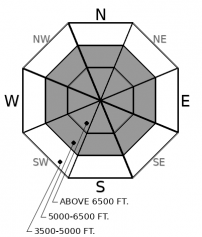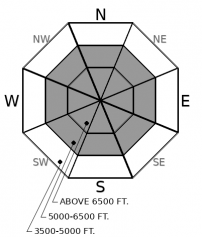| Friday | Friday Night | Saturday | |
|---|---|---|---|
| Cloud Cover: | Mostly Cloudy | Mostly Cloudy | Mostly Cloudy |
| Temperatures: | 32 to 38 deg. F. | 29 to 35 deg. F. | 30 to 40 deg. F. |
| Wind Direction: | Southwest | Southwest | Southwest |
| Wind Speed: | 25G60 | 31G61 | 28G57 |
| Snowfall: | 3" to 7" in. | 0" to 2" in. | 0" in. |
| Snow Line: | 5500' | 5500' | 5500' |
Flathead Range and Glacier National Park
How to read the forecast
Dangerous conditions are developing as a vigorous storm brings heavy snowfall, powerful winds, and rising freezing levels to the Flathead Range and Lake McDonald area. Because natural and remotely triggered avalanches are possible, avoid being on or under steep slopes, where new and drifted snow are forming dense slabs. These slabs are a hazard in themselves; they are also overloading weak snow buried deep in the snowpack. The danger will rise through the day, and may remain elevated Saturday.

3. Considerable
?
Above 6500 ft.
3. Considerable
?
5000-6500 ft.
1. Low
?
3500-5000 ft.
- 1. Low
- 2. Moderate
- 3. Considerable
- 4. High
- 5. Extreme
-
Type ?
-
Aspect/Elevation ?

-
Likelihood ?CertainVery LikelyLikelyPossible
 Unlikely
Unlikely -
Size ?HistoricVery LargeLargeSmall

Natural and human-triggered avalanches that break in the new snow will become ever more likely as new snow accumulates. Avoid being on or under slopes steeper than about 30 degrees with more than about a foot of fresh or drifted snow. The size and likelihood of avalanches will increase as you climb higher in elevation, with the most dangerous terrain near or just below steep, leeward slopes. Shooting cracks and natural avalanches, including those on small slopes, are a clear sign of today's danger.
-
Type ?
-
Aspect/Elevation ?

-
Likelihood ?CertainVery LikelyLikelyPossible
 Unlikely
Unlikely -
Size ?HistoricVery LargeLargeSmall

Adding a rapid load to the snowpack makes it easier to trigger slides that break on old snow well below the snow surface. These can break 2 to 4 feet deep on weak facets and crusts buried earlier this season. These weak structures are most widespread above about 6000 feet on a wide variety of aspects. You can trigger them from below or from adjacent slopes, so avoid being below slopes steeper than about 30 degrees. Whumpfing collapses on low-angle slopes are an unambiguous sign of this danger.
Heavy snowfall, powerful winds, and high freezing levels – there’s little doubt we’ll see some combination of those conditions today across the region. However, it’s not clear how widespread these conditions will be. Models show the storm sideswiping the region as it blasts through Canada. That track favors the Whitefish Range for snowfall. If it swerves more south, the Swan Range, Flathead Range, and Lake McDonald area could also pick up significant snowfall. If snowfall in those areas exceed the forecast totals, the danger may rise to HIGH (Level 4) in those zones. All areas should see powerful winds, especially near ridgecrests and summits, along with freezing levels at or above 5000 feet.
The upshot is that dangerous or very dangerous conditions are developing. If you head into the backcountry – and that includes terrain you access from a ski area – choose a destination where you can avoid being in the runouts of avalanche paths that start above you, particularly those with leeward (facing north to northeast to east) start zones near ridges. Stick to this terrain once you’re in the backcountry if you find roughly a foot or so of new snow. That’s a clear sign that a dangerous Storm Slab avalanche problem has developed.
The new and drifted snow will also increase the likelihood of triggered and natural avalanches that break on weak facet/ crust structures deep in the snowpack. These combinations are most widespread above about 6000 feet, on the slopes that look most attractive for riding because they have the deepest snow coverage. The potential size of these slides is greater in the eastern parts of the forecast region, in the large bowls and long avalanche paths on the east side of the Flathead Range and in the Lake McDonald area. This terrain will also be the most prone to loading from wind-deposited snow, so simply avoid avalanche runouts in mid and upper elevations in these areas.
The avalanche danger will likely remain elevated Saturday, thanks to lingering snowfall and continued winds. An Avalanche Watch remains in effect until 6 PM Saturday.
Heavy snowfall, gusty southwesterly winds, and warm temperatures are forecast for today. The highest snowfall rates are forecast for this morning, with light snow continuing into this evening and tonight. The powerful winds will continue into tomorrow. While they'll be most sustained near ridges, expect them to mix down into more sheltered terrain.
This forecast applies only to backcountry areas outside established ski area boundaries. The forecast describes general avalanche conditions and local variations always occur. This forecast expires at midnight on the posted day unless otherwise noted. The information in this forecast is provided by the USDA Forest Service who is solely responsible for its content.



























